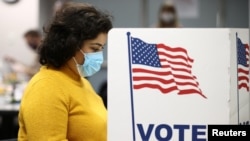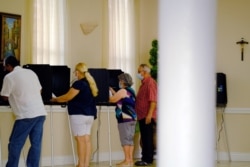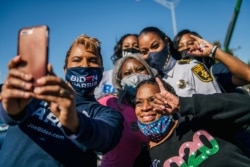Female voters are not a sure bet for Democrats, recent research on voting says.
While Black, Latina and Asian American women voted for Democratic President Joe Biden by large margins, 55% of white women voted for then-incumbent, Republican Donald Trump, and 44% chose Biden, who went on to win.
The data challenge any notion that women are a monolithic voting bloc with a shared sense of identity.
“There's no singular sort of women's vote in the American electorate,” says Claire Gothreau, a research associate at the Center for American Women and Politics (CAWP) at Rutgers. “Yes, women are more likely to vote Democratic than men. But once you look at gender data disaggregated by race, by age group, education, religiosity, there are these really big differences. For example, white women have pretty consistently voted Republican in presidential elections.”
Still, across all age groups, women do tend to vote more Democratic, with more white women voting for Democrats than white men. In addition, a CAWP analysis found that unmarried women tend to vote at a higher rate than unmarried men, but married couples tend to vote at similar rates as each other.
There’s also an education gap, according to the analysis. Educated voters across demographic groups tend to vote more Democratic, but the gap isn’t as large among voters of color. Sixty-four percent of white women with a college degree voted for Biden, while 45% went for Trump.
No matter how they vote, women play a huge role in U.S. elections.
“They've registered and voted at higher rates than men in every presidential election since 1980,” Gothreau says. “They outnumber men, at least in the past couple of elections, by about 10 million. So, even though men outpaced women in terms of some other forms of political engagement like donating and running for office, the fact that women outvote men is meaningful.”
But that doesn’t mean they all vote for female candidates. The numbers suggest that race is a stronger shared identity than gender, Gothreau says.
Meanwhile, women of color are wielding increasing power in the U.S. electorate, Gothreau says. Nonwhite people accounted for about one-third of the electorate in 2020, which is the largest share ever.
The voting power of Black women was evident in the most recent presidential election cycle.
“Black women are a demographic group that tends to turn out in extremely high numbers, and I think that definitely played out in 2020,” Gothreau says. “In key swing states where Black women turned out, in urban areas, in places like Georgia, that was just critical to the Biden victory. And it is the case, particularly in recent elections, that Black women have one of the highest turnout rates.”
And she expects Black women and other women of color to become even more influential at the ballot box going forward.
“More and more, Gen Zers (young people up to age 24) are able to vote, and they’re a more diverse generation,” Gothreau says. “So, I think in the future, we're going to see, in particular, younger women of color holding a lot of sway in our elections.”







